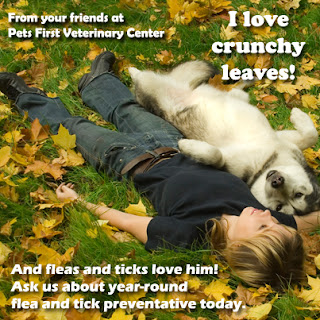Equally important to annual dental exams at
your veterinarian’s practice is home dental care, including brushing your pet’s
teeth every day if possible. AAHA recommends a technique for both younger and
older animals, although it’s easier to start brushing when your pet is young.
To introduce a fearful cat or dog to the idea
of dental care, start slowly and gradually. Dip a finger into beef bouillon
(for dogs) or tuna water (for cats) and gently rub along your pet’s gums and
teeth. The most important area to focus on is the gum line (the crevice where
the gums meet the teeth), where bacteria and food mix to form plaque. Focusing
on the gum line, start at the front of the mouth, then move to the back upper
and lower teeth and gum areas. Once your pet is okay with a little bit of
touching, gradually introduce gauze over your finger and rub the teeth and gums
in a circular fashion.
When your four-legged friend can handle the
gauze, try brushing with a toothbrush specially designed for pets or a very
soft, ultra-sensitive toothbrush designed for people. The bristles should be
held at a 45-degree angle to the tooth surface and be moved in an oval motion.
Scrub in the gum line, as this is where odor and infection begin. Gradually add
special dog/cat toothpaste (flavored with meat or fish), but never use people
toothpaste or baking soda, as both will upset your pet’s stomach.
Use the following process to clean the inside
surfaces of your pet’s teeth:
- Place your hand over your pet’s muzzle from the top
- Gently squeeze and push his lips on one side between the back
teeth (to keep his mouth open)
- Pull his head back gently so his mouth opens
- Brush his teeth on the opposite side
- Repeat this process for the other side
The entire process should only take a minute
or two. If your dog or cat continues to resist, try gently wrapping him in a
large bath towel with only his head sticking out. Above all, avoid
overstraining and keep sessions short and positive. With plenty of praise and
reassurance, your dental sessions can bring the two of you closer---a closeness
that won’t be marred by the perils of dog breath.
Home care can be improved by feeding your pet
an unmoistened dry pet food and offering him hard biscuits after each meal.
Both dry food and hard biscuits produce abrasion to help keep plaque to a
minimum on the crown of each tooth.
Dental care of dogs and cats is one of the
most commonly overlooked areas of pet health care; however, it is necessary to
provide optimum health and quality of life. Diseases of the oral cavity, if
left untreated, are often painful and can lead to more serious health problems
including heart, lung and kidney disease.
AAHA encourages pet owners to regularly
examine their pet’s teeth for signs of periodontal disease, such as brownish
colored teeth; swollen, red, or bleeding gums; persistent bad breath; loose
teeth or loss of teeth; pus between the gums and teeth; broken teeth and any
unusual growth in the mouth. Reluctance to eat, play with chew toys, or drink
cold water are warning signs of periodontal or gum disease. Consult your
veterinarian if you notice any of these signs in your pet to schedule a dental
exam.
There are two critical components of your
pet’s veterinary dental care: oral examinations and dental cleanings.
Veterinary dental care begins at the puppy and kitten life stage. As your pet
ages, your veterinarian will look for developmental anomalies, the accumulation
of plaque and tartar, periodontal disease and oral tumors. Veterinarians can
perform a basic oral examination on patients that are awake. However, when a
cleaning is required, your pet will need to be induced under general anesthesia
wherein a thorough examination will be done prior to the cleaning. Dental
cleanings performed while your pet is awake is not only dangerous for the team
member performing the cleaning but dangerous to your pet as well.
Since there is an element of risk associated
with any medical procedure, it is important that safety precautions are used.
Among the many standards in the dentistry section, AAHA accreditation requires
that veterinarians perform thorough examinations of the teeth and structures of
the oral cavity in patients presented for dental procedures and only properly
trained practice team members perform dental procedures. Additionally, AAHA
Standards recommend that dental procedures are accompanied by pain assessment and
appropriate pain treatment.
For more information on pet dental care, read
our AAHA Dental Care Guidelines article.
Click here for an instructive video by the Cornell Feline Health Center on
brushing your cat’s teeth.
Originally published on Healthy
Pet.

.jpg)
.jpg)
.jpg)
.jpg)